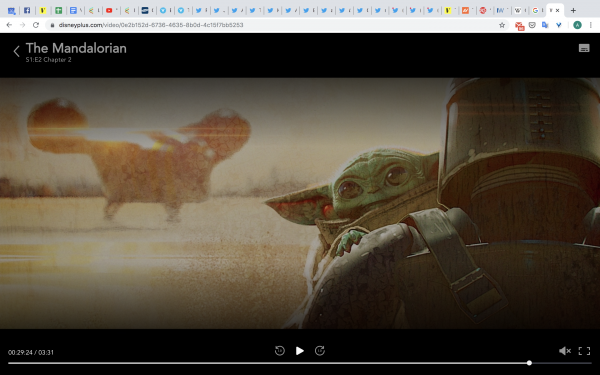
Baby Yoda is perfection, and I won’t hear otherwise. Not that I’m worried anyone will disagree, because this is one take the world seems to stand behind.
The TV show that birthed him, the Disney+ Star Wars series The Mandalorian, got off to a slow start, in part because it’s full of big-name character actors playing unfamiliar intergalactic heroes and villains. But the final moment of its otherwise-unexciting premiere gave many Star Wars fans a sign that The Mandalorian would be more than an expensive exercise in bringing the franchise to streaming TV.
When the Mandalorian saved an infant in a floating bassinet from certain death at the end of the episode, the adorable baby was revealed to be a lot more recognizable than the rest of the show’s new heroes and villains. Because that adorable baby looked a heckuva lot like Yoda.
As far as we know, this character is not the 900-year-old green wiseman that Star Wars fans have long revered; Yoda himself died at the end of Return of the Jedi, which is set five years before the start of The Mandalorian. But the youngster appears to be from the same species as Yoda. And as we learned in episode two, there’s much more to him than his resemblance to one of Star Wars’ most beloved characters: Referred to on the show as “the Child,” he is 50 years old, so still a baby in Yoda years. But he’s shockingly powerful for someone who appears to be just an infant, able to use the Force to take down giant beasts.
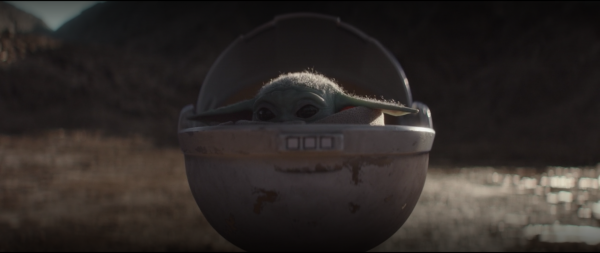
This makes him a great companion for the Mandalorian, who’s committed to protecting Baby Yoda from the dangers of the galaxy after members of what remains of the evil Empire offered him a hefty bounty for bringing the Child to them. The Mandalorian quickly fell in love with the sweet, cooing baby, and refused to let him become little more than a trophy for unfeeling villains.
So did viewers. Predictably, the fact that this big-eyed, big-headed, pure-hearted alien isn’t actually Yoda hasn’t stopped people from dubbing him Baby Yoda. And Baby Yoda has already become an online phenomenon.
Memes, odes to his cuteness, and fanart have spread widely across Twitter and other corners of the internet since The Mandalorian’s November 12 debut, especially after he was granted more screen time in episode two. The character seems to have broadened interest in the show immensely. He clearly appeals not just to Star Wars fans, but a bigger demographic: lovers of all things tiny-baby-adorable.
To many, Baby Yoda is a bright spot in a slow-going series
If The Mandalorian hadn’t leaned into Baby Yoda as hard as it has so far — as it’s done by giving him plenty of screen time in episode two, “The Child,” and episode three, “The Sin” — there’s a chance no one would even be talking about him right now.
Disney hyped up the series ahead of its debut as a live-action Star Wars TV show of grand scale, a first for the franchise. Previous efforts to translate Star Wars for live-action television have notoriously fizzled out, like the aborted Star Wars: Underworld project of the mid-aughts. But The Mandalorian had much more promise from the start.
Disney assembled a team that gave the show immediate credibility: Jon Favreau (Iron Man) as showrunner, a cast that includes Carl Weathers and Werner Herzog, and episode directors like Rick Famuyiwa (Dope) and Taika Waititi (Thor: Ragnarok; Jojo Rabbit) among them. Early promotional photos teased a project reminiscent of the Star Wars movies themselves: There were sandy dunes, a variety of aliens, and plenty of droids. And the mysterious main character (played by Pedro Pascal) was shown to be a bounty hunter in the vein of fan-favorite villains Boba and Jango Fett. What wasn’t to love?
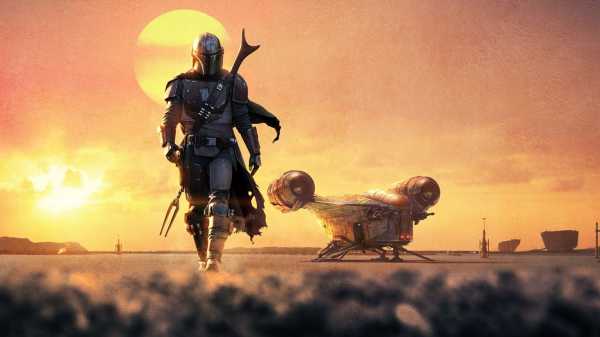
But critics raised plenty of complaints when The Mandalorian debuted as the crown jewel of Disney+’s original programming lineup. Vox critic at large Emily VanDerWerff called the first episode “fundamentally empty entertainment and not a great harbinger for many Disney+ original programs to come.” Slate described it as “truncated and half-sketched.” Entertainment Weekly wrote that “this was a very strange debut, merging grim toughness with mawkish softening twists.”
The negative response hinged on the concern that The Mandalorian would inch toward its meaningful reveals, a questionable approach to a story whose hero’s primary trait is how little is known about him. (It didn’t help that Disney+ chose not to screen the series for critics ahead of its premiere, which didn’t give them anything to go on beyond the first episode.)
Baby Yoda, at least, was a point of interest. Some spoiler-y reviews of his surprise introduction made mention of the baby’s appearance more dismissively, writing off the character as an obvious marketing ploy or cheap and unoriginal twist. Alan Sepinwall of Rolling Stone: “Even the twist at the very end — that the Mandalorian’s latest target is a baby from the same species as Yoda — echoes the plot of the Clone Wars film.” VanDerWerff of Vox: “You’re probably just seeing the big-eyed, big-eared baby alien as yet another merchandising opportunity.”
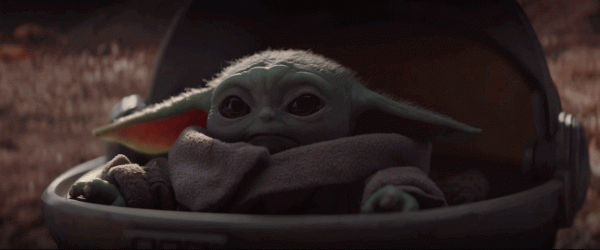

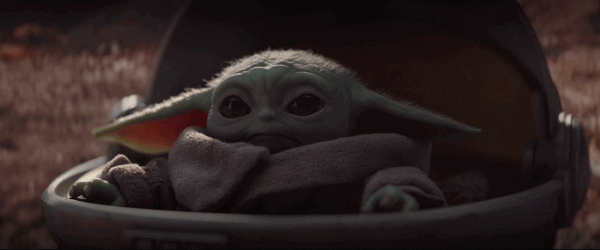
Indeed, right before the release of episode three, reports emerged that Baby Yoda merchandise would be hitting shelves very soon (apparently after a purposeful delay intended to help “preserve the surprise of the character’s reveal”).
But toys and plushes will arrive into a world where Baby Yoda is already a more fleshed-out character than some critics expected. In episode two, fittingly called “The Child,” The Mandalorian made an effort to show off that this baby is a meaningful part of the show, not just a toy in the making.
The show is ostensibly focused on its title character, but in “The Child,” every move the Mandalorian made was followed by the camera holding on Baby Yoda’s reaction, with clear affection for his emotive blue eyes and goofy oversized coat. When the Mandalorian boarded his ship, Baby Yoda waddled along behind him. (The character was brought to life through a combination of animatronic puppeteering and computer-generated graphics, lending a nice sense of practicality to his movements.) When the Mandalorian got roughed up in a fight while trying to protect his ship, Baby Yoda outstretched his little arm to reach for his new friend. When the Mandalorian was busy fighting some bad guys, the show paused to let us know what Baby Yoda was up to, and it turned out he was eating a frog that made him sick. (He’s even cute when he’s sick!)
All of these scenes added lighthearted moments to a show that had initially come off as meditative, if not quite dour. The addition of a pure-hearted baby alleviated the solitude and tension that comes with a story of a silent bounty hunter.
It also made the show more memorable and evocative. So few events occurred in episode one that it quickly escaped recall. But “The Child” began to properly introduce this instantly likable mystery character with an apparent tie to one of Star Wars’ most beloved figures. And episode three, “The Sin,” further balanced Baby Yoda’s extreme cuteness with intrigue well enough to prove that his appeal is no fluke — by putting him in real danger and introducing life-or-death stakes that forced the stoic Mandalorian into full-on Good Dad mode to make sure the kid stayed alive.
Werner Herzog, who plays a man known as the Client, has even admitted that Baby Yoda has made him “cry,” which encapsulates his power better than anything.
Entertainment outlets are eager to celebrate the Baby Yoda goodness. Vox is not immune to that impulse, clearly! Because we would give our lives to protect Baby Yoda’s in an instant. He’s a new friend who is feeling out a world that evil bounty hunters didn’t want him to survive in. How could anyone not love a creature this cute?
The desire to protect Baby Yoda at all costs has been the dominant response from Mandalorian viewers and non-viewers alike, as fans have waxed poetic about the character’s button nose and shining eyes online.
“The bottom line is that Baby Yoda is the best part of The Mandalorian so far, and right now, the main thing persuading me to watch more episodes,” Vulture’s Jen Chaney wrote after episode two. At Wired, Emmy Grey Ellis acknowledged that a contingent of haters are protesting Baby Yoda as nothing more than marketing — and then argued that “Baby Yoda is, in fact, so lovable that its lovability is evidence of storytellers and character designers at the peak of their powers.”
Ellis continued: “Typically, building a character out of elements people are sure to adore is a ticket to Try-Hardsville. … Baby Yoda is different. The character is simply a mashup of the most beloved being in the Star Wars universe, Disney’s cuteness formula, and a superbaby.”
Baby Yoda has definitely cemented The Mandalorian as one of the cutest shows on streaming, against all odds. But his cuteness is only one reason why Baby Yoda fever has exploded. Another, more major reason is that Disney made a very smart move in choosing to unveil the character the way it did, and meting out his development by releasing The Mandalorian one episode at a time.
Baby Yoda’s secret weapon: The Mandalorian’s release schedule
Disney+ launched on a Tuesday, along with the first episodes of its initial wave of exclusive original programming. The most advertised of the lot was The Mandalorian, what with the weight of Star Wars and a $100 million budget behind it.
Disney had announced in late August that it would release new episodes of its original Disney+ series weekly, rather than drop them all season at once.
But the company did launch The Mandalorian (and other Disney+ originals) on a slightly compressed schedule, with the second episode premiering just three days after the first. Future new episodes will also premiere on Fridays. This ended up being a smart play by Disney, especially in the wake of critics’ reactions to The Mandalorian’s first episode.
By launching the show’s first two installments so close together, Disney encouraged viewers to at least give The Mandalorian two episodes’ worth of their time. It’s hard to say whether skeptics who raised an eyebrow at Baby Yoda’s surprise appearance would have returned for episode two if they’d been asked to wait a full week (or longer) to see it. The episode’s arrival in quick succession helped make a case that The Mandalorian has more charm than the first episode implied — namely because of Baby Yoda, but also because of a more exciting story and brighter set design in general.
The show’s more traditional release schedule has fueled the excitement around Baby Yoda. While Netflix and Amazon Prime Video typically release their original series one full season at a time, encouraging viewers to consume all of the episodes as quickly as possible, Disney+’s decision to release episodes weekly allows those episodes more time and space to drive individual conversation. And Baby Yoda has certainly given viewers something to talk about.
As Vox sister site the Verge has noted: “Tying new content to beloved franchises, then doling it out a bit at a time is a way for Disney, in particular, to keep subscribers hooked.” Making sure viewers got to know Baby Yoda in episodes two and three was a way to assuage any fears that The Mandalorian would be all style with little substance, or that Baby Yoda himself would be a cash grab trotted out by the show to sell merchandise. Now, many viewers are in love with the lil’ cutie. And for Star Wars fans who want to know every inch of the franchise’s expansive canon, the mystery of what Baby Yoda will teach us about the Yoda species is alluring.
With each passing episode, those fans will have to subsist on the latest Baby Yoda developments until the next episode arrives. And they’ll have to stay on Disney+ to do so, to make sure that Baby Yoda is A-OK.
Because if something ever happens to him, Disney, y’all will have thousands of us Baby Yoda Stans knocking on your door with pitchforks.
Sourse: vox.com



